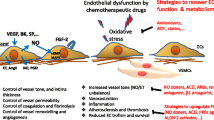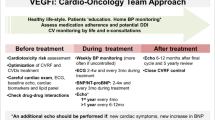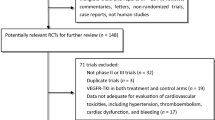Abstract
Background
Although we previously demonstrated that paclitaxel and carboplatin chemotherapy (TCchem) is associated with vascular toxicities, the underlying mechanisms remain unclear. Cisplatin is known to inhibit PPARα following microvascular damage to the kidneys. The primary aim of this study was to evaluate whether TCchem induces vascular endothelial dysfunction via systemic PPARα deficiency. In addition, human umbilical vein endothelial cells (HUVECs) were used to elucidate the mechanisms responsible for TCchem-induced vascular toxicities.
Methods
This study enrolled 45 gynecological cancer patients with normal lipid profiles who underwent surgical treatment followed by TCchem. The elevated triglyceride (TG) group included patients (n = 19) who exhibited hypertriglyceridemia during TCchem, and the stable TG group (n = 15) included patients with a normal TG level. Eleven patients exhibiting hypertriglyceridemia during TCchem were administered bezafibrate (fibrate group). Endothelial dysfunction was evaluated based on flow-mediated dilation (FMD) values and serum pentraxin-3 levels measured before TCchem and immediately after the final TCchem. HUVECs were used to elucidate the biological mechanisms underlying the endothelial dysfunction induced by TCchem.
Results
The administration of TCchem induced hypertriglyceridemia in 66 percent of the participants, and bezafibrate reduced the serum TG levels. Meanwhile, the decrease in flow-mediated dilatation (%FMD) induced by TCchem improved following treatment with bezafibrate. The serum pentraxin-3 level increased rapidly after TCchem and decreased following bezafibrate treatment. An in vitro examination demonstrated TCchem attenuated nitric oxide production and PPARα activity in HUVECs, which was partially improved by treatment with bezafibrate.
Conclusion
Bezafibrate prevents endothelial dysfunction induced by TCchem via TG-dependent and TG-independent mechanisms.






Similar content being viewed by others
Abbreviations
- PtChem:
-
Platinum-based chemotherapy
- TG:
-
Triglycerides
- TCchem:
-
Paclitaxel and carboplatin combination chemotherapy
- FMD:
-
Flow-mediated dilation
- PPARα:
-
Peroxisome proliferator-activated receptor-α
- OC:
-
Ovarian cancer
- EC:
-
Endometrial cancer
- CVD:
-
Cardiovascular disease
- LDL:
-
Low-density lipoprotein
- HDL:
-
High-density lipoprotein
- hsCRP:
-
High-sensitivity C-reactive protein
- CDDP:
-
Cisplatin
- CBDCA:
-
Carboplatin
- PTX:
-
Paclitaxel
References
Vogelzang NJ, Frenning DH, Kennedy BJ (1980) Coronary artery disease after treatment with bleomycin and vinblastine. Cancer Treat Rep 64:1159–1160
Doll DC, List AF, Greco FA et al (1986) Acute vascular ischemic events after cisplatin-based combination chemotherapy for germ-cell tumors of the testis. Ann Intern Med 105:48–51
Lederman GS, Garnick MB (1987) Pulmonary emboli as a complication of germ cell cancer treatment. J Urol 137:1236–1237
Haugnes HS, Aass N, Fossa SD et al (2007) Components of the metabolic syndrome in long-term survivors of testicular cancer. Ann Oncol 18:241–248
Nuver J, Smit AJ, Sleijfer DT et al (2004) Microalbuminuria, decreased fibrinolysis, and inflammation as early signs of atherosclerosis in long-term survivors of disseminated testicular cancer. Eur J Cancer 40:701–706
Vaughn DJ, Palmer SC, Carver JR et al (2008) Cardiovascular risk in long-term survivors of testicular cancer. Cancer 112:1949–1953
Meinardi MT, Gietema JA, van der Graaf WT et al (2000) Cardiovascular morbidity in long-term survivors of metastatic testicular cancer. J Clin Oncol 18:1725–1732
Sagstuen H, Aass N, Fossa SD et al (2005) Blood pressure and body mass index in long-term survivors of testicular cancer. J Clin Oncol 23:4980–4990
Haugnes HS, Wethal T, Aass N et al (2010) Cardiovascular risk factors and morbidity in long-term survivors of testicular cancer: a 20-year follow-up study. J Clin Oncol 28:4649–4657
Sekijima T, Tanabe A, Maruoka R et al (2011) Impact of platinum-based chemotherapy on the progression of atherosclerosis. Climacteric 14:31–40
Portilla D, Dai G, McClure T et al (2002) Alterations of PPARalpha and its coactivator PGC-1 in cisplatin-induced acute renal failure. Kidney Int 62:1208–1218
Portilla D, Dai G, Peters JM et al (2000) Etomoxir-induced PPARalpha-modulated enzymes protect during acute renal failure. Am J Physiol Renal Physiol 278:F667–675
Schonefeld M, Noble S, Bertorello AM et al (1996) Hypoxia-induced amphiphiles inhibit renal Na+ , K(+)-ATPase. Kidney Int 49:1289–1296
Portilla D, Schnackenberg L, Beger RD (2007) Metabolomics as an extension of proteomic analysis: study of acute kidney injury. Semin Nephrol 27:609–620
Vamecq J, Latruffe N (1999) Medical significance of peroxisome proliferator-activated receptors. Lancet 354:141–148
Haubenwallner S, Essenburg AD, Barnett BC et al (1995) Hypolipidemic activity of select fibrates correlates to changes in hepatic apolipoprotein C-III expression: a potential physiologic basis for their mode of action. J Lipid Res 36:2541–2551
Schoonjans K, Staels B, Auwerx J (1996) Role of the peroxisome proliferator-activated receptor (PPAR) in mediating the effects of fibrates and fatty acids on gene expression. J Lipid Res 37:907–925
Mantovani A, Garlanda C, Bottazzi B et al (2006) The long pentraxin PTX3 in vascular pathology. Vascul Pharmacol 45:326–330
Fazzini F, Peri G, Doni A et al (2001) PTX3 in small-vessel vasculitides: an independent indicator of disease activity produced at sites of inflammation. Arthritis Rheum 44:2841–2850
Kohn S, Fradis M, Podoshin L et al (1997) Endothelial injury of capillaries in the stria vascularis of guinea pigs treated with cisplatin and gentamicin. Ultrastruct Pathol 21:289–299
Kohn S, Fradis M, Ben-David J et al (2002) Nephrotoxicity of combined treatment with cisplatin and gentamicin in the guinea pig: glomerular injury findings. Ultrastruct Pathol 26:371–382
Kirchmair R, Walter DH, Li M et al (2005) Antiangiogenesis mediates cisplatin-induced peripheral neuropathy: attenuation or reversal by local vascular endothelial growth factor gene therapy without augmenting tumor growth. Circulation 111:2662–2670
Yoshikawa A, Saura R, Matsubara T et al (1997) A mechanism of cisplatin action: antineoplastic effect through inhibition of neovascularization. Kobe J Med Sci 43:109–120
Belotti D, Vergani V, Drudis T et al (1996) The microtubule-affecting drug paclitaxel has antiangiogenic activity. Clin Cancer Res 2:1843–1849
Steel DM, Whitehead AS (1994) The major acute phase reactants: C-reactive protein, serum amyloid P component and serum amyloid A protein. Immunol Today 15:81–88
Hefler LA, Concin N, Hofstetter G et al (2008) Serum C-reactive protein as independent prognostic variable in patients with ovarian cancer. Clin Cancer Res 14:710–714
Garlanda C, Hirsch E, Bozza S et al (2002) Non-redundant role of the long pentraxin PTX3 in anti-fungal innate immune response. Nature 420:182–186
Mantovani A, Garlanda C, Doni A et al (2008) Pentraxins in innate immunity: from C-reactive protein to the long pentraxin PTX3. J Clin Immunol 28:1–13
Li S, Wu P, Yarlagadda P, Vadjunec NM et al (2004) PPAR alpha ligand protects during cisplatin-induced acute renal failure by preventing inhibition of renal FAO and PDC activity. Am J Physiol Renal Physiol 286:F572–580
Li S, Basnakian A, Bhatt R et al (2004) PPAR-alpha ligand ameliorates acute renal failure by reducing cisplatin-induced increased expression of renal endonuclease G. Am J Physiol Renal Physiol 287:F990–998
Li S, Gokden N, Okusa MD et al (2005) Anti-inflammatory effect of fibrate protects from cisplatin-induced ARF. Am J Physiol Renal Physiol 289:F469–480
Nagothu KK, Bhatt R, Kaushal GP et al (2005) Fibrate prevents cisplatin-induced proximal tubule cell death. Kidney Int 68:2680–2693
Vogel RA, Corretti MC, Plotnick GD (1997) Effect of a single high-fat meal on endothelial function in healthy subjects. Am J Cardiol 79:350–354
Eiselein L, Wilson DW, Lame MW et al (2007) Lipolysis products from triglyceride-rich lipoproteins increase endothelial permeability, perturb zonula occludens-1 and F-actin, and induce apoptosis. Am J Physiol Heart Circ Physiol 292:H2745–2753
Lundman P, Eriksson MJ, Silveira A et al (2003) Relation of hypertriglyceridemia to plasma concentrations of biochemical markers of inflammation and endothelial activation (C-reactive protein, interleukin-6, soluble adhesion molecules, von Willebrand factor, and endothelin-1). Am J Cardiol 91:1128–1131
Wang L, Gill R, Pedersen TL et al (2009) Triglyceride-rich lipoprotein lipolysis releases neutral and oxidized FFAs that induce endothelial cell inflammation. J Lipid Res 50:204–213
Rowinsky EK (1997) The development and clinical utility of the taxane class of antimicrotubule chemotherapy agents. Annu Rev Med 48:353–374
Kureishi Y, Luo Z, Shiojima I et al (2000) The HMG-CoA reductase inhibitor simvastatin activates the protein kinase Akt and promotes angiogenesis in normocholesterolemic animals. Nat Med 6:1004–1010
Laufs U, Liao JK (1998) Post-transcriptional regulation of endothelial nitric oxide synthase mRNA stability by Rho GTPase. J Biol Chem 273:24266–24271
Wolfrum S, Jensen KS, Liao JK (2003) Endothelium-dependent effects of statins. Arterioscler Thromb Vasc Biol 23:729–736
Brouet A, Sonveaux P, Dessy C et al (2001) Hsp90 and caveolin are key targets for the proangiogenic nitric oxide-mediated effects of statins. Circ Res 89:866–873
Martin G, Duez H, Blanquart C et al (2001) Statin-induced inhibition of the Rho-signaling pathway activates PPARalpha and induces HDL apoA-I. J Clin Invest 107:1423–1432
Yano M, Matsumura T, Senokuchi T et al (2007) Statins activate peroxisome proliferator-activated receptor gamma through extracellular signal-regulated kinase 1/2 and p38 mitogen-activated protein kinase-dependent cyclooxygenase-2 expression in macrophages. Circ Res 100:1442–1451
Acknowledgments
We are grateful to Junko Hayashi, Akiko Hashimoto, and Kumiko Satoh for secretarial assistance. This study was supported by JSPS KAKENHI Grant Number 24592535.
Conflict of interest
The authors declare that they have no conflict of interest.
Author information
Authors and Affiliations
Corresponding author
Electronic supplementary material
Below is the link to the electronic supplementary material.
About this article
Cite this article
Watanabe, A., Tanabe, A., Maruoka, R. et al. Fibrates protect against vascular endothelial dysfunction induced by paclitaxel and carboplatin chemotherapy for cancer patients: a pilot study. Int J Clin Oncol 20, 829–838 (2015). https://doi.org/10.1007/s10147-014-0779-y
Received:
Accepted:
Published:
Issue Date:
DOI: https://doi.org/10.1007/s10147-014-0779-y




